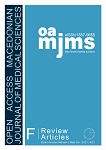Efficacy and Safety of Candesartan 16 mg versus 64 mg Candesartan in Renal Disease Patients with Proteinuria: A Systematic Review and Meta-analysis
DOI:
https://doi.org/10.3889/oamjms.2021.7596Keywords:
Candesartan, Proteinuria, Blood pressure, Efficacy, SafetyAbstract
BACKGROUND: Chronic kidney disease (CKD) is a global health burden in the world. One of the complications of CKD is proteinuria. Candesartan is a drug that is often used in CKD patients to improve proteinuria. There are several studies that suggest that using a higher dose of candesartan can further improve its effectiveness in reducing proteinuria in CKD patient
AIM: This paper is aimed to review the effectiveness and safety at a supramaximal dose of 64 mg to a dose of 16 mg of candesartan.
METHODS: We performed a literature search using PubMed, SCOPUS, EuropePMC, ProQuest, and Cochrane Central Databases using these keywords: “candesartan” and “16 mg” and “64 mg” or “proteinuria renal disease” or “albuminuria” and “blood pressure” that were published within the year of 1980–2021. Preferred Reporting Items for Systematic reviews and Meta-Analysis (PRISMA) protocol were used to conduct this meta-analysis. We included randomized controlled trials, prospective cohort, retrospective or clinical observational evaluating the effect of candesartan in 16 mg or 64 mg in proteinuria renal disease patients regardless of clinical status. Non-randomized, controlled trials reporting efficacy were included if these trials were in the scope of our topic. Duplicate studies were excluded. Dichotomous variables were analyzed with the Mantel-Haenszel statistical method using risk ratio as the summary statistic and reported with 95% confidence intervals (CIs).
RESULTS: Forty-six studies were initially generated using our search keyword. After applying inclusion and exclusion criteria, we included two studies in our analysis. Our pooled analysis found that candesartan 16mg dosage administration, compared to 64mg, was not associated with proteinuria reduction (std mean diff: −10.92 [95% CI: −40.09–18.26], p = 0.46).
CONCLUSION: Candesartan supramaximal dosage 64 mg did not differ significantly in proteinuria reduction and blood pressure reduction against candesartan 16 mg. More studies are needed to determine this efficacy and safety.Downloads
Metrics
Plum Analytics Artifact Widget Block
References
Lv JC, Zhang LX. Prevalence and disease burden of chronic kidney disease. Adv Exp Med Biol. 2019;1165:3-15. https://doi.org/10.1007/978-981-13-8871-2_1 PMid:31399958 DOI: https://doi.org/10.1007/978-981-13-8871-2_1
Eijkelkamp WB, Zhang Z, Remuzzi G, Parving HH, Cooper ME, Keane WF, et al. Albuminuria is a target for renoprotective therapy independent from blood pressure in patients with type 2 diabetic nephropathy: Post hoc analysis from the Reduction of Endpoints in NIDDM with the Angiotensin II Antagonist Losartan (RENAAL) trial. J Am Soc Nephrol. 2007;18(5):1540-6. https://doi.org/10.1681/ASN.2006050445 PMid:17409317 DOI: https://doi.org/10.1681/ASN.2006050445
Schmieder RE, Klingbeil AU, Fleischmann EH, Veelken R, Delles C. Additional antiproteinuric effect of ultrahigh dose candesartan: A double-blind, randomised, prospective study. J Am Soc Nephrol. 2005;16:3038-45. https://doi.org/10.1681/ASN.2005020138 PMid:16120821 DOI: https://doi.org/10.1681/ASN.2005020138
Rossing K, Schjoedt KJ, Jensen BR, Boomsma F, Parving HH. Enhanced renoprotective effects of ultrahigh doses of irbesartan in patients with type 2 diabetes and microalbuminuria. Kidney Int. 2005;68:1190-8. https://doi.org/10.1111/j.1523-1755.2005.00511.x PMid:16105050 DOI: https://doi.org/10.1111/j.1523-1755.2005.00511.x
Burgess E, Muirhead N, de Cotret PR, Chiu A, Pichette V, Tobe S. Supramaximal dose of candesartan in proteinuric renal disease. J Am Soc Nephrol. 2009;20(4):893-900. https://doi.org/10.1681/ASN.2008040416 PMid:19211712 DOI: https://doi.org/10.1681/ASN.2008040416
Hou FF, Xie D, Zhang X, Chen PY, Zhang WR, Liang M, et al. Renoprotection of optimal antiproteinuric doses (ROAD) study: A randomized controlled study of benazepril and losartan in chronic renal insufficiency. J Am Soc Nephrol. 2007;18(6):1889-98. https://doi.org/10.1681/ASN.2006121372 PMid:17494885 DOI: https://doi.org/10.1681/ASN.2006121372
Aranda P, Segura J, Ruilope LM, Aranda FJ, Frutos MA, López V, et al. Long-term renoprotective effects of standard versus high doses of telmisartan in hypertensive nondiabetic nephropathies. Am J Kidney Dis. 2005;46(6):1074-9. https://doi.org/10.1053/j.ajkd.2005.08.034 PMid:16310573 DOI: https://doi.org/10.1053/j.ajkd.2005.08.034
Moher D, Liberati A, Tetzlaff J, Altman DG, Group P. Preferred reporting items for systematic reviews and meta-analyses: The PRISMA statement. PLoS Med. 2009;6(7):e1000097. https://doi.org/10.1371/journal.pmed.1000097 PMid:19621072 DOI: https://doi.org/10.1371/journal.pmed.1000097
Rossing K, Christensen PK, Hansen BJ, Carstensen B, Parving HH. Optimal dose of candesartan for renoprotection in Type 2 diabetic patients with nephropathy: A double-blind randomized cross-over study. Diabetes Care 2003;26(1):150-5. https://doi.org/10.2337/diacare.26.1.150 PMid:12502672 DOI: https://doi.org/10.2337/diacare.26.1.150
Weinberg MS, Weinberg AJ, Cord R, Zappe DH. The effect of high-dose angiotensin II receptor blockade beyond maximal recommended doses in reducing urinary protein excretion. J Renin Angiotensin Aldosterone Syst. 2001;2(1):S196-8. https://doi.org/10.1177/14703203010020013401 PMid:28095227 DOI: https://doi.org/10.1177/14703203010020013401
Jafar TH, Stark PC, Schmid CH, Landa M, Maschio G, de Jong PE, et al, AIPRD Study Group. Progression of chronic kidney disease: The role of blood pressure control, proteinuria, and angiotensin-converting enzyme inhibition: A patient-level meta-analysis. Ann Intern Med. 2003;139(4):244-52. https://doi.org/10.7326/0003-4819-139-4-200308190-00006 PMid:12965979 DOI: https://doi.org/10.7326/0003-4819-139-4-200308190-00006
Lewis JB, Ritz E, Atkins RC, Rohde R, Raz I, Collaborative Study Group. Renoprotective effect of the angiotensin receptor antagonist irbesartan in patients with nephropathy due to Type 2 diabetes. N Engl J Med. 2001;345:851-60. https://doi.org/10.1056/NEJMoa011303 PMid:11565517 DOI: https://doi.org/10.1056/NEJMoa011303
Brenner BM, Cooper ME, de Zeeuw D, Keane WF, Mitch WE, Parving HH, et al, RENAAL Study Investigators. Effects of losartan on renal and cardiovascular outcomes in patients with type 2 diabetes and nephropathy. N Engl J Med. 2001;345(12):861-9. https://doi.org/10.1056/NEJMoa011161 PMid:11565518 DOI: https://doi.org/10.1056/NEJMoa011161
Kidney Disease Outcomes Quality Initiative (K/DOQI). K/DOQI clinical practice guidelines on hypertension and antihypertensive agents in chronic kidney disease. Am J Kidney Dis. 2009;43(1):S1-290. PMid:15114537
Downloads
Published
How to Cite
Issue
Section
Categories
License
Copyright (c) 2021 Andry Gonius, Arnaz Adisaputra, Farahdina Farahdina, Salsabila Rifdah, Astried Indrasari, Artaria Tjempakasari (Author)

This work is licensed under a Creative Commons Attribution-NonCommercial 4.0 International License.
http://creativecommons.org/licenses/by-nc/4.0








